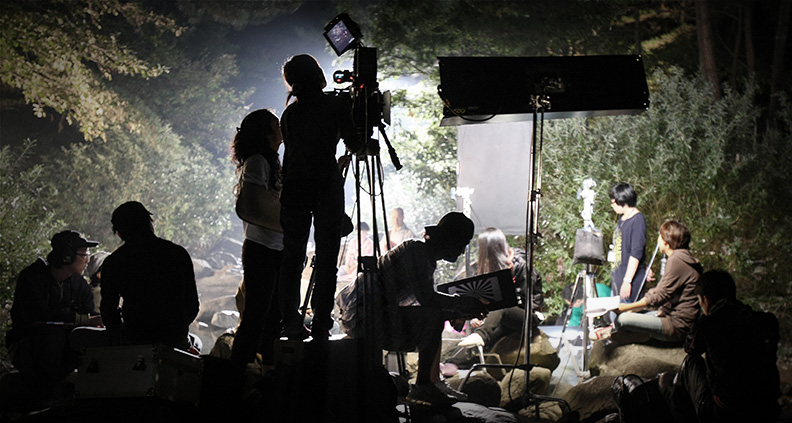Know Your Crew: Line Producer Angela Sostre’s Tips for Building a Better Budget
As part of Know Your Crew—Film Independent’s regular Tuesday night educational series giving an in-depth look at key below-the-line positions—Angela Sostre stopped by Film Independent to discuss the role of the line producer. Having line-produced over 40 features (among them: Behaving Badly, Cold Turkey and Camp X-Ray) Sostre offered an insightful glimpse at the nitty-gritty details that her job description entails.
But first, with all the possible variations of “producer” credits in Hollywood, what exactly is a line producer? Sostre’s definition is simple: line producers are like an event planner for a film—someone who takes care of the logistics and practical aspects of a production so that the above-the-line crew can focus on the film’s creative aspects. Sostre then broke down the main details a line producer focuses on while offering some pretty good tips.
WHAT TO DO: DEVELOPMENT

Break it down. Once a script is ready, a line producer is usually called on-board to create a realistic schedule and rough line-by-line budget breakdown in order to start raising funds. Now, “rough budget” doesn’t mean a budget will change from $3 million to $8 million, but rather, allocations within those $3 million could shift, i.e. money saved on travel could be used to offset the cost of an extra half-day of shooting.
Adjustments are inevitable. The goal, Sostre said, is to think: “What’s the lowest amount of money this film can possibly be made for without sacrificing the story and vision?” Initial adjustments can include choosing to shoot in a state with a higher tax incentive or deciding if it’s really necessary to include a golden retriever for 12 scenes (more on that later.)
WHAT TO DO: PRE- AND POST-PRODUCTION

Time is money. Yay, your funds are secured! Now that this film is a go, it’s time to call back your LP. A line producer will be working closely with the producer to work out schedules for talent, crew and all other logistics. Sostre notes that sometimes availability is an issue for working actors, but she offers a tip: there’s a period just after pilot season is over when actors who may have been planning to be unavailable for the next few months suddenly have time—if their pilot isn’t picked up.
Location, location, location. Choosing where to shoot isn’t only about what will look good, but also about what will work logistically. Permits play a big role in making sure you’re getting your money’s worth. Based on her experience, Sostre recommended shooting in the jurisdiction of Film LA (LA’s official film office). Cities outside of this area, like Pasadena or West Hollywood get costly and/or have more requirements. Some less obvious factors when finding the perfect location include parking and identifying “film friendly” neighborhoods. To hedge your bets, Angela suggests not cutting corners by committing to a family/friend’s property under the illusion that it will be free. Shooting in your Mom’s neighborhood for free could suddenly require a cop, film monitor and fire safety officer.
Misconceptions. Some less obvious factors when finding the perfect location include parking and accessibility to banks. To hedge your bets, Angela suggests not cutting corners by committing to a family/friend’s property under the illusion that it will be free. Sometimes getting the permit for a production truck to park in your mom’s neighborhood ends up being costlier than shooting at another location. Shooting in your Mom’s neighborhood for “free” might suddenly require a cop, film monitor and fire safety officer
WHAT TO DO: BUDGET BUSTERS

The A, B, C’s of K-I-D-S. While a script may seem to hinge upon the performance of a great child actor, Angela says there are many things to consider. Children under 18 are required to work fewer hours per day and can’t work late like adults. They must have hours allocated for an on-set Studio Teacher (which you must pay) to make sure they don’t fall behind in school. Along with other restrictions, these could cut into production time and, thus, money. Some ways around this are working with twins (though this could be double the cost…), using adult actors who look young or simply cutting the child character’s screen time.
Pet peeves. Remember that 12-scene golden retriever? Well… he’s not cheap. If you go by the book, you have the cost of a trained animal with one or more on-set trainers, transportation fees, insurance, accommodations, etc. But let’s say your executive producer already has a retriever and you want to reduce the cost? Here’s another place Sostre suggests not cutting corners. The EP’s dog may not be trained, and a simple scene where he crosses the room can put you behind schedule by hours. You might end up paying for OT or even an extra day of production as a result of the energy spent on an untrained animal—with all that entails in crew accommodations.
And…Action! Special effects, whether they’re stunts or graphics, will always need room for a bigger budget. On-set effects require talent, coordinators, insurance, safety costs, equipment, back-up equipment, supervision… the list goes on. When a scene must inevitably have special effects, it’s better to over-budget from the start than to try and simply rely on an upfront deal from an effects company. Back to Angela’s first solution: try to see how many special effects scenes can be reduced in order to reduce the amount of time these costs will incur. Again: it all comes back to time.

While this conversation and Q&A only scratched the surface of the line producer’s job, Tuesday’s main takeaway was to always be realistic about your costs and not create the budget based on incentives and money-savers. Because, let’s face it, any film production will have unexpected bumps that can potentially put you over budget. In theory, “you can do anything,” Sostre said about working on a film production. “But everything has risks, and it’s the line producer’s job to choose wisely.”
For more information about upcoming Film Independent events, click here. To learn more about our Film Education programs, click here.
Learn how to become a Member of Film Independent by visiting our website, and click here to subscribe to our YouTube channel.
